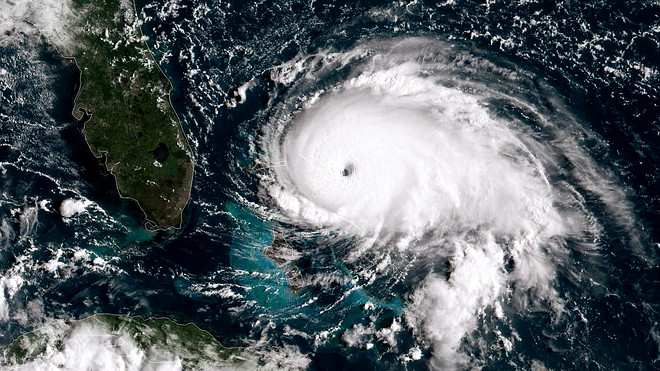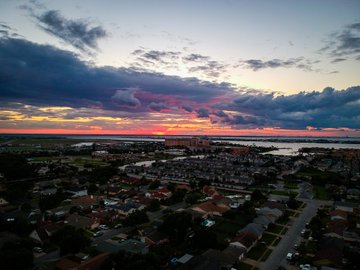Hurricane Season Begins
Let’s explore what’s already happened in this year’s hurricane season and look to what the future might bring.
Displayed above is a photo of Hurricane Dorian from last summer’s hurricane season. Photo Credits: Marketwatch
June 13, 2020
What is Expected of 2020’s Hurricane Season
As we start off this year’s hurricane season, it’s only natural to wonder what is in store for this summer. Hurricane season started on June 1st and will last until November 30th. The National Oceanic and Atmospheric Administration (NOAA) announced in May that they predict this year’s hurricane season as above average in terms of the number of named storms, hurricanes, and major hurricanes. To be specific, they predict there will be 13-19 named storms, 6-10 hurricanes, and 3-6 major hurricanes; this compares with the average season having 12 named storms, 6 hurricanes, and 3 major hurricanes. Of course these are only predictions, but the NOAA is 70% confident. The Weather Company has similar predictions with 18 named storms, 9 hurricanes, and 4 major hurricanes (which are hurricanes category 3 or higher). One major factor in how this year’s season will play out lies in El Niño and La Niña. While you probably watched a Bill Nye video about this in 5th grade, I’ll give you a little refresher. In simple terms, El Niño and La Niña have to do with the temperature of the oceans in the Equatorial Pacific with El Niño being associated with warmer ocean temperatures and La Niña being associated with cooler ocean temperatures. This year’s predictions believe that conditions will be neutral or trend towards La Niña which has been associated with more active hurricane seasons including the 2017 season that resulted in Hurricane Harvey. How does this affect the hurricane season? It all has to do with the wind and the atmosphere. While El Niño creates enhanced vertical wind shear (changes in the direction and speed of the wind) and more atmospheric stability, La Niña suppresses vertical wind shear and fosters an unstable atmosphere leading to more hurricanes with higher intensity.
Tropical Storm Cristobal
Hurricane season got off to a quick start with Tropical Storm Cristobal as the third named storm of 2020 and the first of the official hurricane season. While it is more known that Cristobal hit the Gulf Coast, it started off by hitting parts of Central America. The main areas impacted were El Salvador, Guatemala, and Honduras which collectively had about 457,000 people affected by wind, rain, flooding, and/or landslides and 34 deaths. After hitting Central America, Cristobal was weakened to a tropical depression only to regain strength and become a tropical storm again. After fueling up in the Gulf Coast, Cristobal made landfall in America with impacts reaching from Texas to Florida. Storm effects varied throughout the impacted area which ranged from flooding, to power outages, to tornadoes. Places with very low elevation like New Orleans experienced flooding, while areas to the east of the storm experienced tornadoes. When it came to Texas though, the storm shied away. Even though this storm brought many people hardship, there are always beautiful moments of people coming together. One example is in our very own state in Corpus Christi where a lifeguard and other concerned beach-goers saved two girls who were caught in the rough waves (watch the rescue here: https://www.facebook.com/watch/?v=658482794699394). In Louisiana, the Mandeville Fire/EMS saved 10 people stranded in cabins and brought them to safety. After the storm was finished, many people saw the light at the end of the tunnel in the form of a beautiful sunset spanning across the Gulf Coast.
Though the future is uncertain and sometimes we face really difficult situations, we can always look to the sunsets at the end of the storm and know that everything will be okay. So even though this year’s storm predictions aren’t ideal, all we can do is trust that things will be alright in the end and dance in the rain (as long as we have rain jackets of course).
So What Do We Do Now?
Obviously we can’t control hurricanes, but there are a few ways we can be prepared for a storm. First of all: food and snacks. When a storm comes, you can’t just drive to Chick-fil-A and get some nuggets. Even inside your home, if the power goes out, you can’t use any of the appliances like the fridge or the microwave. So what do you eat and drink? When it comes to beverages, try and stock up on packs of bottled water in case you can’t get water from your fridge and/or if the water filtration system malfunctions. You can get other drinks that come in individual packaging as well, but let’s face it: Coke is not nearly as good when it’s warm. When it comes to food, make sure you stock up on foods that can be kept at room temperature and eaten without needing to be cooked. Also make sure that when you’re expecting a storm’s arrival, you charge any devices you might need, like your phone. You may also want to purchase a charging pack that way if the storm stays out for a while, you can recharge your phone (just make sure you charge the pack before the storm). Also remember that when a storm comes, your phone service may cut out, so be sure to download anything you might need on your phone. When the power goes on and off repeatedly, it’s a good idea to start unplugging your devices, lamps, and other technology to avoid a power surge from frying all of your electronics. It is also a good idea to stock up on candles and lighters and make sure you have plenty of things to keep you entertained. If you find your home at a major risk in the storm, start moving valuables up as high as you can and pack an evacuation bag. When it comes to packing a bag, pick a bag around the size of a backpack (that way it’s easier to carry). Fill it with a few outfits and items that you use on a day to day basis like your toothbrush. It is also important to make sure your valuables are safe since many flooded homes run the risk of being robbed. If some of your valuables are small (like your phone), you can put them into a Ziploc bag in your backpack so that they won’t get wet. If the items are larger, such as a computer, do your best to hide them in an elevated area. Above all, do your best to relax and help out a neighbor if you get the chance, because we’re all in this together (cue the High School Musical soundtrack). Be sure to stay safe and focus and what brings you joy and you’ll make it through any storm that comes your way.
Sources:
2020 Atlantic Hurricane Season Expected to Be Active, Colorado State University Says in Latest Outlook. (2020, June 05). Retrieved June 12, 2020, from https://weather.com/safety/hurricane/news/2020-06-04-atlantic-hurricane-season-outlook-june-csu-noaa-the-weather
Brackett, R. (2020, June 08). 29 People Rescued from Cabins Cut Off by Cristobal Storm Surge in Louisiana. Retrieved June 12, 2020, from https://weather.com/storms/hurricane/news/2020-06-08-tropical-depression-cristobal-louisiana-mississippi-flooding-power
Brackett, R., & Childs, J. (2020, June 08). Flooding Hits Louisiana, Mississippi, Florida as Tropical Storm Cristobal Dumps Rain. Retrieved June 12, 2020, from https://weather.com/storms/hurricane/news/2020-06-07-tropical-storm-cristobal-impacts-gulf-coast-florida-louisiana
Busy Atlantic hurricane season predicted for 2020. (n.d.). Retrieved June 12, 2020, from https://www.noaa.gov/media-release/busy-atlantic-hurricane-season-predicted-for-2020
Impacts of El Niño and La Niña on the hurricane season: NOAA Climate.gov. (2014, May 30). Retrieved June 12, 2020, from https://www.climate.gov/news-features/blogs/enso/impacts-el-ni%C3%B1o-and-la-ni%C3%B1a-hurricane-season
MEXICO & CENTRAL AMERICA: Tropical Storm Amanda (Pacific) and Tropical Storm Cristobal (Atlantic) – Flash Update No. 03 (As of 4 June 2020) – El Salvador. (n.d.). Retrieved June 12, 2020, from https://reliefweb.int/report/el-salvador/mexico-central-america-tropical-storm-amanda-pacific-and-tropical-storm-cristobal
Moreno, J. (2020, June 07). Water rescue caught on camera in Corpus Christi as Tropical Storm Cristobal brings rough surf to Texas coast. Retrieved June 12, 2020, from https://www.ksat.com/news/local/2020/06/07/water-rescue-caught-on-camera-in-corpus-christi-as-tropical-storm-cristobal-brings-rough-surf-to-texas-coast/
Nbc. (2020, June 08). Tropical Storm Cristobal impacts today and tonight. Retrieved June 12, 2020, from https://mynbc15.com/news/local/tropical-storm-cristobal-impacts-today-and-tonight
US Department of Commerce, & National Oceanic and Atmospheric Administration. (2009, March 26). What are El Nino and La Nina? Retrieved June 12, 2020, from https://oceanservice.noaa.gov/facts/ninonina.html
What is wind shear and how does it impact hurricanes, other tropical cyclones? (n.d.). Retrieved June 12, 2020, from https://www.accuweather.com/en/weather-news/what-is-wind-shear-and-how-does-it-impact-hurricanes-other-tropical-cyclones/330987
Photos:
Buckeye, G. (2020, June 08). #Sunset tonight courtesy of the outer fringes of #Cristobal 🌴🌅🌀Galveston, TX | June 7, 2020#txwx #glswx #houwx #stormhour #thephotohour #dronehour #dji #dronephotography pic.twitter.com/ZKuNfzAFTe. Retrieved June 12, 2020, from https://twitter.com/NMBBuckeye/status/1269808977044520960
Ostro, S. (2020, June 07). Stunning #sunset on the edge of #Cristobal’s clouds #gawx pic.twitter.com/TWeJl4VdWx. Retrieved June 12, 2020, from https://twitter.com/StuOstro/status/1269446563870453760
Pesce, N. (2020, May 19). Hurricane season is coming – this is one reason why the storms keep getting stronger. Retrieved June 12, 2020, from https://www.marketwatch.com/story/hurricane-season-is-coming-and-this-is-one-reason-why-the-storms-keep-getting-stronger-2020-05-19




